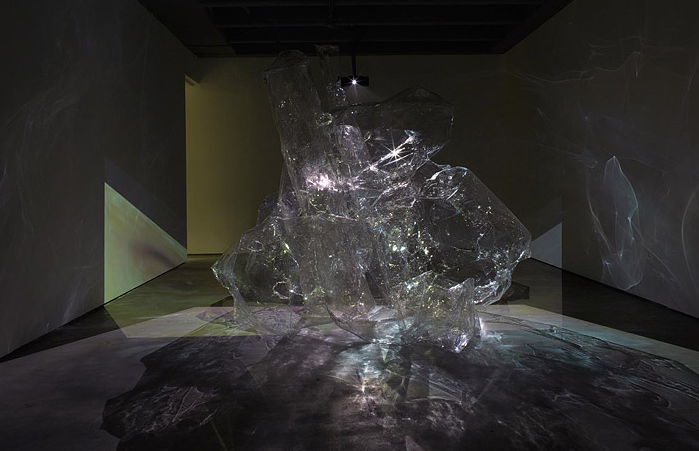Soft Core, ex. cat. (Sydney: Casula Powerhouse, 2017).
The Empty Sculptures are barely there but they are in our way. In 2002, Mikala Dwyer began making these glistening globules, these see-through bubble-baubles, and she shows no sign of stopping. They’ve become a staple in her practice, part of her repertoire—a standard.
Dwyer makes them from sheets of a clear plastic used in vacuum forming. In that process, the plastic is heated and sucked down over a mould. It cools and goes rigid, holding its new shape. Forms can be made swiftly, repeatedly. However, Dwyer’s process is rather more primitive and protracted—she foregoes the mould. She softens the plastic using a heat gun and bends it by hand. She can heat areas of the sheet selectively, so some parts are pliable while others hold firm. She fuses the molten plastic to itself, conjuring three dimensions from two, typically (but not always) sealing up volumes of air. The material is unwieldy, wobbly, and has to be wrestled with—you can only make what it will let you make. Results are unrepeatable. Dwyer says: ‘I hate working with it. It’s disgusting. But I constantly find new possibilities for it.’
Space hungry but insubstantial, the Empty Sculptures can be a pain to store and ship but can be made in situ—and floor loadings are never an issue. Like Fred Sandback’s string lines, they offer a nifty, practical solution for taming gaping exhibition spaces on a tight budget, countering horror vacui. They are space sponges.
Dwyer has made Empty Sculptures in different shapes and sizes, offering them as individuals and in clusters, and in diverse scenarios. One floated on a swamp in an upstate New York sculpture park. A cumulus chandelier of them is suspended over the bar in that swanky Melbourne eatery, Vue de Monde, fifty-five storeys up, where the air is thin.
The Empty Sculptures take on different characters in different circumstances. As we see them—and see through them—they disappear into the whiteness of white-cube galleries, into the busyness of abandoned industrial spaces, and into the lush greenery of nature. Sometimes Dwyer presents them on their own; sometimes she has them conversing and fucking with other materials, forms, and tropes. She’s even used them as planters for a hanging garden.
Dwyer is committed to being non-committal, neither this nor that. She is forever poised over binaries, escaping them, defined by them. The Empty Sculptures have an in-between quality: bulky/weightless, abject/hygienic, primitive/plastic. They may be crudely made but they can look translucent and sublime—like some CGI-type special effect. Despite being fixed and stationary, they sometimes seem to be in motion, morphing, becoming, hatching—liquid. They suggest boulders but are quite the opposite: being hollow (all skin), synthetic, transparent, and as light as a feather. (They strike me as odd inclusions in a show called Soft Core. They are surely more Rigid Crust or Hard Cell.)
The Empty Sculptures are inchoate, suggestive. They recall art forms, from primitive standing stones to refined biomorphic modernist sculptures (some are punctured with holes, flaunting their Hepworth-Moore pedigree). They also recall products of nature: boulders, ice, bubbles, cells. And we can project our thoughts onto them, as we see faces in clouds or in fire. They could be scrying tools—mystic portals.
Indeed, Dwyer described her installation, A Shape of Thought (2007/12), as ‘hauntological’—Jacques Derrida’s contradiction-in-terms conflating being (ontology) and non-being (haunting). In a darkened room, Dwyer emphasised her Empty Sculptures’s spooky potential by projecting videos of eyes—hers and her father’s—onto them. These projections partly passed through the blobs (and through one another) onto the floor, and partly reflected off them, leaving luminous trails on the walls. It’s as though the puffed-up sculptures were ectoplasm, manifesting at the junction of opposed psyches—symptoms of a relationship, indexes of daddy-daughter stuff. Were we to attend to their forms and effects, as we might divine deep truths from patterns of tea leaves? And, if we did, would we really discover the shapes of the Dwyers’s thoughts, or just those of our own?
Interpretation abhors a vacuum.
[IMAGE: Mikala Dwyer A Shape of Thought 2007/12]
